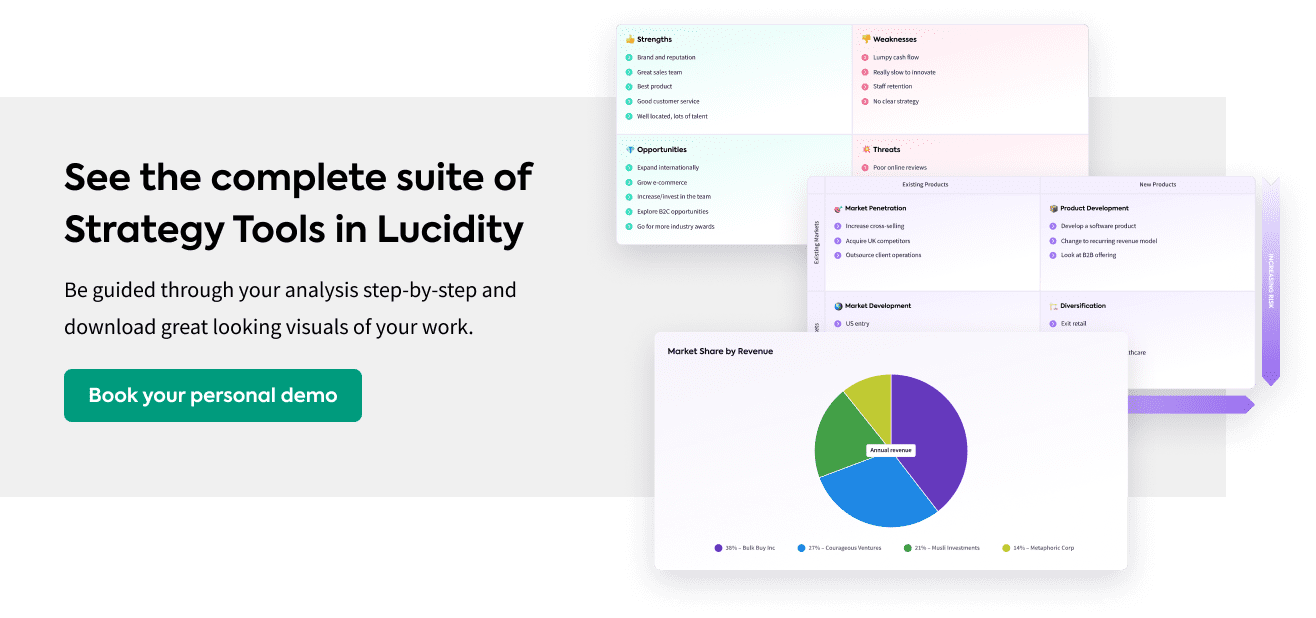Strategic frameworks love a good matrix and, although less well known than SWOT Analysis, SOAR can be a great vehicle to driving strategic discussion and ambition.
What is a SOAR Analysis?
A SOAR Analysis is a framework for identifying Strengths, Opportunities, Aspirations and Results. It is presented as a 2×2 matrix and works in any business involved in any marketplace. Unlike some other frameworks, SOAR marries up fact finding about the company and position, alongside the desires of the stakeholders.
Based on the above grid structure, the top row focuses on the facts of the business, identifying your strengths and your opportunities currently presented. These two segments are the same as the ones you find in SWOT Analysis.
The bottom row of SOAR focuses on what you want to achieve, your aspirations for the business and then way you’re going to measure it via hard data in results.
SOAR is a great method to taking stock of your strengths and opportunities and aligning them with the outcomes you want.
What are the advantages of SOAR?
The advantages of SOAR are as follows:
- It’s simple to understand and easy to use
- It works as a framework for an individual or group of people
- Unlike many strategic frameworks, it includes some tangible goals alongside the facts of the business and market
- It’s easier to understand the direction of the business by mapping strengths with aspirations
What are some of the limitations of SOAR?
There are a few disadvantages of SOAR:
- There are no concepts of weaknesses or threats to the company
- If you do it alongside SWOT you’re repeating certain sections
- It is easy to be too broad
- The aspirations or results of the business suggest the main owners or stakeholders need to be doing the SOAR
How do you make the most out of SOAR?
SOAR isn’t very well known but can be a great summary to employees once other frameworks have been used to devise a strategy. It focuses on the positives, the direction and the desired results.
To get the most out of a session for SOAR you should:
- Collect the positive feedback from customers and employees
- Ask a cross-disicpline group of employees for the strengths and weaknesses
- Always be honest – this is an internal tool
What preparation should be done before a SOAR?
Assuming you are the owner of the business there is no specific preparation required, but it’s helpful to have knowledge of the following:
- Current positive client relationships
- Example good case studies of sales and service
- Latest news in your market or clients markets
- Positive employee feedback
If in a group, these can be shared via an email beforehand or presented on the day.
Can SOAR be used for departmental strategies?
There’s no reason why your SOAR framework can’t be applied to your departmental strategy, it’s a great way to summarise any strategic plan for employees. If you’re using the framework for areas such as Marketing or Product, then your Aspirations and Results would be specific to your department. For example, an aspiration of a Marketing Strategy might be to become the largest trafficked site in their industry, the Result would be a key value of monthly traffic.
What’s the best medium for running a SOAR session?
SOAR works best when put together by a cross-disciplined team either physically or virtually. Select your participants based on their experience across the business and market knowledge. You need a mix of employees to ensure you capture all aspects of the business and produce the best SOAR.
Given a large part of SOAR is also developing your intent via aspirations and results, the key decision makers for the business need to be involved.
How often is SOAR updated?
It is best practise to review your SOAR on an annual basis, alongside your overall strategy. Think of SOAR as a great way to summarise your strategic thinking – the positives of the business mixed with the direction and exciting future of your company.
Who invented SOAR?
SOAR was invented by Jacqueline Stavros, David Cooperrider & D. Lynn Kelley in their paper SOAR: A new approach to strategic planning, published in 2003.
Ready to start your SOAR? Check out our how to create a SOAR article!














